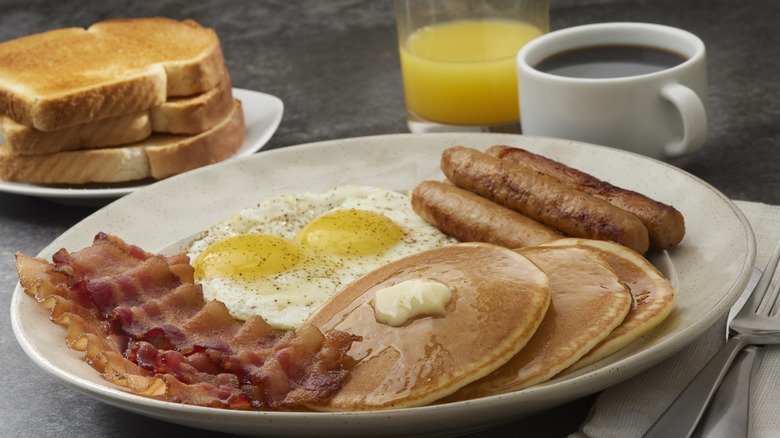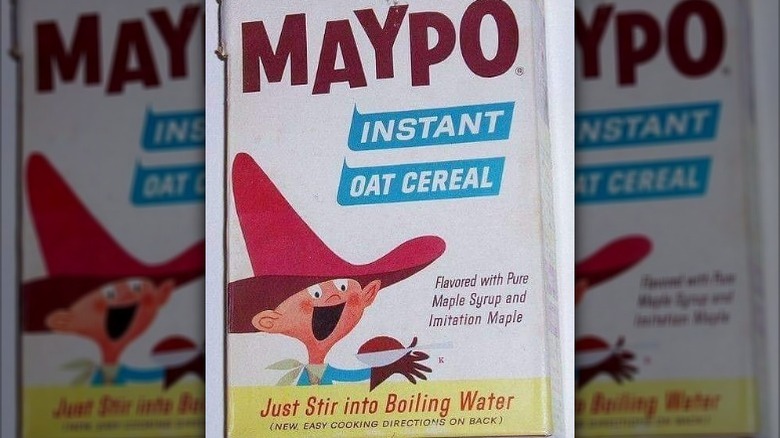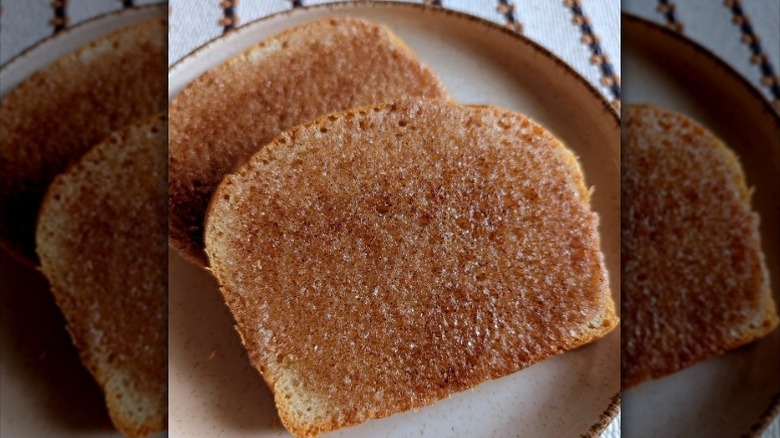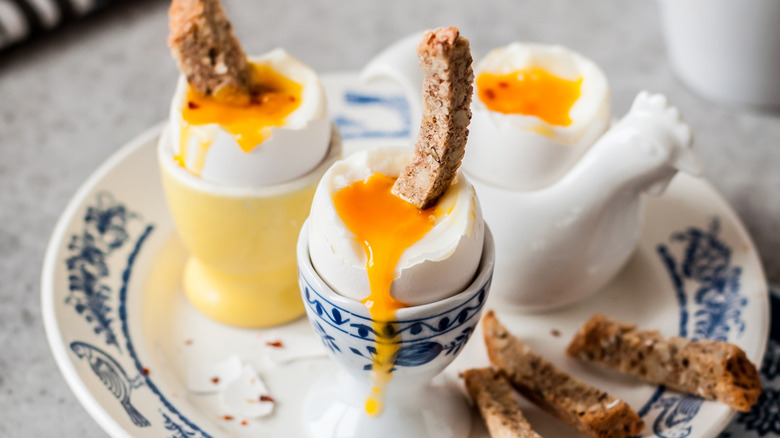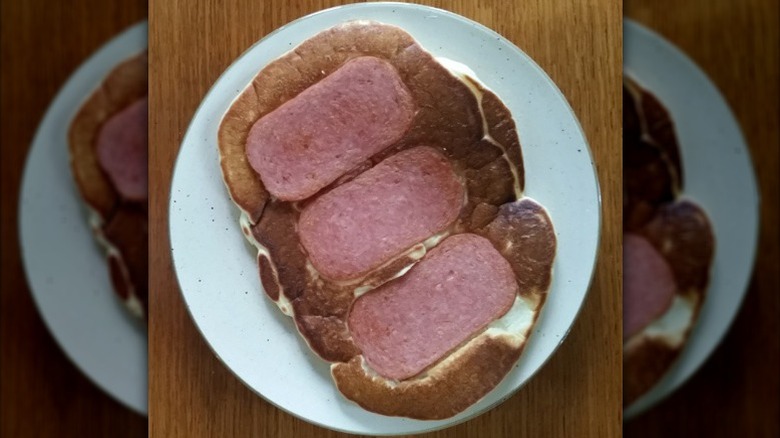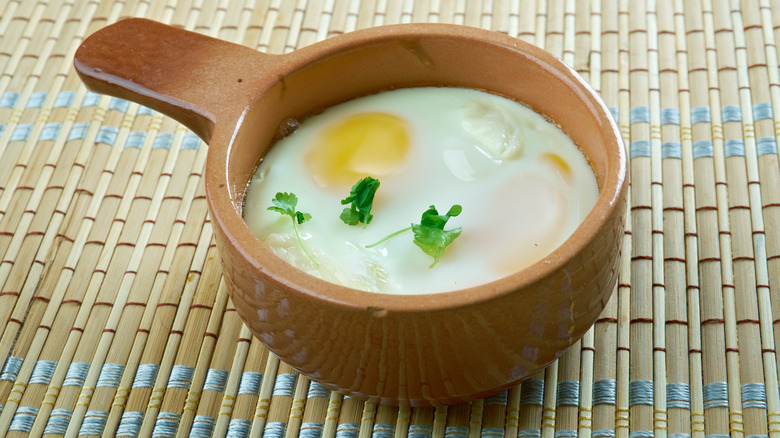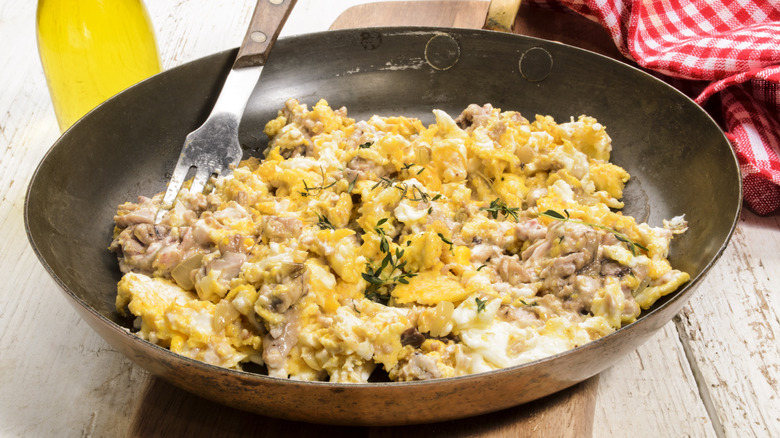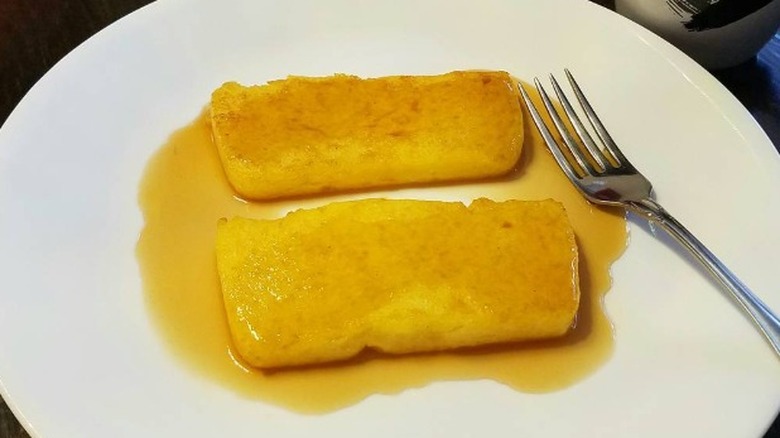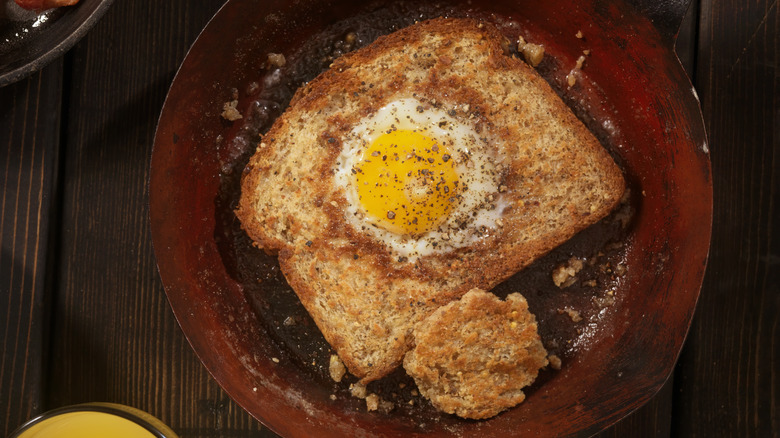Classic Breakfast Foods That Vanished From Tables
We may receive a commission on purchases made from links.
Breakfast has been considered the most important meal of the day by most for decades, if not centuries. Yet despite that idea and due to changing trends, many now skip breakfast altogether, opt for convenience and prefer having it on the go, or look for easy breakfast recipes that are quick to prepare. But let's jump back to the late 19th and early-to-mid-20th century when breakfast meals were constantly evolving due to historical events like the Great Depression and the Industrial Revolution. Back then, people started their day with whatever they could afford or chose meals based on the kind of work they'd be doing.
Later, when women started working and convenience food took over, breakfasts shifted toward cereals and other meals that could be cooked quickly. Given all the changes that were happening in the country during this time, it isn't surprising that new recipes for the first meal of the day emerged and remained popular for a while. However, even though simple classic options like Maypo, dippy eggs, and popcorn cereal ruled the breakfast scene once upon a time, they soon faded into obscurity. There are plenty of reasons why Americans moved on from these foods with an obvious one being changing preferences. That said, anyone who is into vintage food trends and curious about what folks once preferred for breakfast has landed at the right place.
Maypo
Oatmeal is considered one of the healthiest breakfasts these days. But, what if we told you a form of it was all the rage even in the '50s and '60s? Maypo was actually one of the earliest flavored oatmeals. It gained popularity after the release of a 1956 television advertisement that featured an animation of a little boy saying "I WANT MY MAYPO!" in a rather endearing way. Strangely enough, quite a few packages of Maypo called it a "oat cereal," which might seem slightly bizarre since it was prepared by mixing in hot water, just like any other oatmeal. It's also worth noting that Maypo was actually created three years before the TV ad campaign came around.
While it's difficult to pinpoint exactly when this classic breakfast food saw its decline, it eventually did, possibly because of the introduction of better options. However, interestingly Maypo is still available on the Homestat Farm website – the company that eventually acquired the brand in 2001. It's now just called oatmeal instead of oatmeal cereal.
Sadly, despite still being available, barely anyone knows about Maypo these days besides those who enjoyed the oatmeal when it was at its peak. But if you'd like to revisit a nostalgic treat to know how it tasted, you know where you can get it. You can also try recreating a version of the original at home by flavoring regular oatmeal with maple syrup. We'd also recommend tossing in some nuts for crunch to give your breakfast oatmeal a delicious upgrade.
Cinnamon toast
It's likely that most of you folks may know about Cinnamon Toast Crunch cereal, considering it's a favorite these days. But what you might not know is that the cereal was inspired by an old-school and rather simple breakfast meal called cinnamon toast. Though the exact timeline of when this dish was trending is slightly unclear, it's believed it was pervasive in the early 20th century as a few recipes for it appeared back then. It was quite budget-friendly, needing only a few basic ingredients, and was particularly loved by kids, which isn't really surprising given its sweet flavor. Cinnamon toast mostly stayed a beloved breakfast treat until the cereal version took over. Well, that and possibly also because other options became more appealing after a point.
As for its history, cinnamon toast originally emerged in Europe as a simpler alternative to French Toast. It possibly found its way to the United States via European immigrants and soon became a go-to. Even though people may have moved on from this simple breakfast from yesteryear, luckily, anyone who wants to try it out can make it at home in no time. To prepare it the old-school way, start with toasting some slices of bread, then apply mounds of butter on it, and top that with brown sugar and powdered cinnamon. After that, bake the toast until the sugar has caramelized slightly, which makes it almost like a simplified version of a buttery cinnamon roll.
Dippy eggs
This adorably named old-school breakfast meal, as you may have guessed, featured eggs as the star ingredient. Dippy eggs were a simple breakfast that people loved to eat back in the day. The dish is originally a British classic that made its way to America.
This breakfast treat involved soft-boiling eggs and placing them in fancy egg cups, then serving them alongside strips of toast. The eggs were cracked from the top so the runny yolks could be visible, and the toast strips were dipped in the eggs — hence the moniker. Many also loved the idea of the yolks dripping down when the toast was dipped in it. Some even called the dish dippy eggs with soldiers, referring to the toast strips as soldiers. The dish may have been popular in various parts of the United States, but the name mostly stuck around in Pennsylvania and Mid-Atlantic regions.
These days, soft-boiled eggs in general are barely preferred, let alone dippy eggs. Sure, some may enjoy it for nostalgia's sake, but besides that, the appeal has largely faded. Those who fancy trying this classic forgotten breakfast treat can easily prepare it at home by boiling eggs for five minutes, as that's all it takes to get those perfectly runny yolks. Place them in an egg cup, crack the top gently, season with some salt and pepper, then go ahead and dip in the soldiers.
Spam cakes
Though Spam isn't strictly a breakfast food item today, it was loved as the first meal of the day in the 20th century with one popular recipe being Spam cakes. Betty Crocker and Spam teamed up to create this breakfast recipe which appeared in an advertisement in 1957. These cakes (which were essentially pancakes) were pretty easy to make and fit the popular trend of making quick breakfasts with convenience foods in that era. All one had to do was prepare a batter using Bisquick mix, brown slices of Spam on one side and flip them over, then pour the batter on top. The breakfast dish was ready as soon as the pancakes were cooked on both sides. Spam cakes offered a lovely combination of sweet and savory flavor. Although there weren't any instructions on how to serve these cakes, it's easy to assume that they tasted best with a drizzle of pancake syrup.
Too bad this once admired breakfast food soon lost its appeal, though it's unclear exactly why. But, if you're really fond of Spam and pancakes, and are also curious about how this vintage breakfast item tastes, there's no reason not to give this recipe another chance. When making Spam cakes, you can consider making a homemade pancake batter if you'd like to customize it. Besides that, avoid cutting the canned meat into very thick slices – a common mistake many make when cooking Spam which can increase the cooking time.
Milk toast
As the name may have given it away, milk toast was indeed a simple toast topped with milk, or more specifically hot milk that was lightly seasoned. This dish was created in the United States, making it an all-American breakfast food.
Even though the name may seem quite literal, interestingly it was also often related to a comic strip character named Caspar Milquetoast who became popular in the early 20th century. Milquetoast was portrayed as quite cowardly and timid and somehow that was linked to the breakfast item as it would break apart easily — much like the character. However, the recipe for this dish seemed to have come around for the first time all the way in 1840, well before the comic strip's debut.
Another fun fact about the breakfast food is that it was usually given to people who were feeling under the weather. Having said that, there's little clear documentation on how the dish eventually became a beloved breakfast staple. Well, the two obvious reasons could have been its simple flavors and ease of preparation. All one needed to do was toast as many slices of bread as they'd like, spread some butter on them, and cut the slices into cubes. The toasted bread cubes were topped with scalding milk that was seasoned with salt, sugar, and powdered cinnamon. Some folks even preferred leaving the toast whole instead of chopping it up. Unfortunately though, this dish is no longer a breakfast favorite despite its simplicity.
Popcorn cereal
Generally speaking, popcorn has a pretty fascinating history. But what's even more interesting is that this beloved movie-time treat was relished as a breakfast meal. This was especially true in the late 19th and early 20th centuries. Plus, during the Great Depression, popcorn became a go-to because it was affordable. So people enjoyed eating it in every way they could, perhaps including for breakfast by topping it with milk. There were essentially two ways popcorn cereal was enjoyed. Most simply poured milk on the popped snack, while a few instead ground the two ingredients to create a porridge-like breakfast meal. Soon, the appeal of this old-school breakfast was lost as classic cereals were introduced to the market and took the country by storm.
However, there's also a theory behind why popcorn cereal may have seen a decline, besides the fact that other options took over. Companies that manufactured cereals didn't want to invest in the idea of selling popcorn in boxes. They were worried that most people would start making it at home given how easy the process was (and still is), which would eventually result in low sales.
It's easy to assume that most people today may find the idea of the crunchy snack soaked in milk quite weird. But if you overlook the soggy texture of the popcorn, one can argue that the breakfast meal may have actually tasted delicious when topped with nuts, seeds, and fresh fruits. So, it's surely worth trying.
Shirred eggs
Shirred eggs were a breakfast classic, also served to first class passengers on the Titanic. The term "shirred" first emerged in the United States and the basic concept was to bake the eggs in a dish. The first recipe with the title "shirred eggs" appeared in 1879 and it involved baking eggs in a dish until the whites were just cooked and the yolks were still runny. The eggs were also topped with butter, pepper, and salt before being served. A recipe that came around a little later in 1898 even suggested not seasoning them at all, as that would mask the flavor of the eggs.
Later, a version featuring heavy cream as one of the main ingredients caught on. The idea of shirred eggs ultimately turned into baking eggs along with cream and topping it all with salt and pepper. After their popularity in the late 19th and early 20th centuries, shirred eggs saw a resurgence in the '50s and '60s as newspapers published articles about them, but they soon disappeared. However, considering how easy it is to prepare them, anyone into vintage breakfast recipes should definitely give them a shot. The best part about shirred eggs is they can be customized beyond their original recipe by tossing in some cheese, fresh herbs, and spices of choice. You can also top them with breadcrumbs to give them a crunchy texture, which is actually how they were served on the Titanic.
Popovers
While some may say popovers are very similar to the British Yorkshire pudding, the two had their differences. Popovers used butter, unlike the British classic which uses meat drippings. They were once a preferred breakfast option and also eaten for other meals, whereas the British counterpart was usually always a part of a traditional Sunday roast lunch. That said, popovers were actually inspired by Yorkshire pudding after immigrants from England got them over to the United States. Though one of the first detailed recipes for this dish appeared in 1876, it isn't clear when it actually originated. But, it's evident that Americans switched some of the ingredients in the original recipe of Yorkshire pudding, which eventually led to the emergence of popovers. They are named for the way the batter puffed and popped when baked.
Popovers were versatile enough to be enjoyed with both sweet and savory accompaniments. Plus, as the recipe started to spread across the United States, people began coming up with different versions, much like they do with most other dishes. Many folks added purees to the batter, while a variation with garlic and herbs got particularly popular in Portland, Oregon. Today, popovers unfortunately aren't a common breakfast option like they once were. However, making them from scratch is pretty easy, which is a definite plus and a reason to try them. Prepare a simple batter by mixing together flour, eggs, milk, and butter, then transfer it to a muffin tin and bake away until the batter pops.
Scrambled brains and eggs
The idea of eating brains may sound extremely unappealing to many of you, but interestingly, this organ was once quite loved. Brains were actually seen as a perfectly ordinary choice among organ meat, which led to people cooking them with eggs for breakfast. Scrambled brains and eggs were once a common breakfast fixture in the Southern states. This dish was made by searing brains (pork brains specifically) until they were almost cooked, then eggs were tossed in. Everything was also lightly seasoned, usually just with salt and pepper, though some may have added extra seasonings and spices.
It is believed that scrambled brains and eggs were created by farming families — those who kept livestock, but it's unclear exactly when. The dish, however, was featured in a cookbook in 1896 and was quite preferred in the early and mid 20th centuries. Since scrambled brains and eggs were a Southern staple, unsurprisingly, they were served with biscuits. The idea of eating the meat caught on so much that pork brains with milk gravy in a can soon hit the market. This canned meat was a Southern speciality in the 1950s, and is actually still available. However, people did eventually stop eating this dish for an array of reasons, with one being that brains had a high cholesterol content. Though this breakfast food may be out of vogue, if you're into trying exotic offal, we'd say go for it.
Fried cornmeal mush
Sure, many of you might know about cornmeal, but we bet you've never heard of fried cornmeal mush, a Midwestern breakfast favorite from yesteryear. This classic was prevalent during the Great Depression and helped a lot of families get through those difficult times as it was cost-effective. Preparing it was a simple task, which made it even more appealing. The process started with making the cornmeal base or "mush" by boiling the cornmeal with water and salt. Once it would cook and thicken, it was cooled and usually cut into rectangles, then shallow-fried. Though it can be assumed people ate the fried mush just by itself during the Great Depression, it was later enjoyed with maple syrup.
Despite its popularity during the Great Depression, this dish's origin actually goes way back. It was quite a staple for the Mesoamerican indigenous people. In fact, not surprising, but corn itself was a go-to for them and so was grinding it. Cornmeal mush was actually introduced in Europe in the 1500s and after a few centuries, it made its way back to America and became a favorite. However, now the appeal this old-school breakfast once had is mostly lost. Nonetheless, considering the ease of preparation, it's worth giving this recipe a go.
Egg in a hole
Egg in a hole was a vintage breakfast meal that turned classic fried eggs paired with toast into something a little more playful. As simple as it sounds, the dish egg in a hole was indeed, an egg cooked within a hole made in a slice of bread. One of its earliest recipes came around in the 1890s, featured in the "Boston Cooking School Cookbook." This item became a go-to in the late 19th century, and stayed so even in the next century until it faded out of the limelight.
It also went by various other names, like "egg with a hat," "egg in a basket," "gashouse egg," and "egg in a frame." In fact, the recipe from the 1890s called it an "egg with a hat," but eventually, the name egg in a hole mostly stuck for this classic breakfast treat. The hat reference was because the recipe suggested placing the center cut portion of the toast on top of the egg once it was cooked.
This vintage food actually arrived in the United States via immigrant communities. Soon, it became a hit breakfast food across the country. Of course, this was because the recipe was handed down among people. Even though it has vanished from breakfast tables today, revisiting a classic egg in a hole recipe can be a fun take on simple fried eggs with toast.
